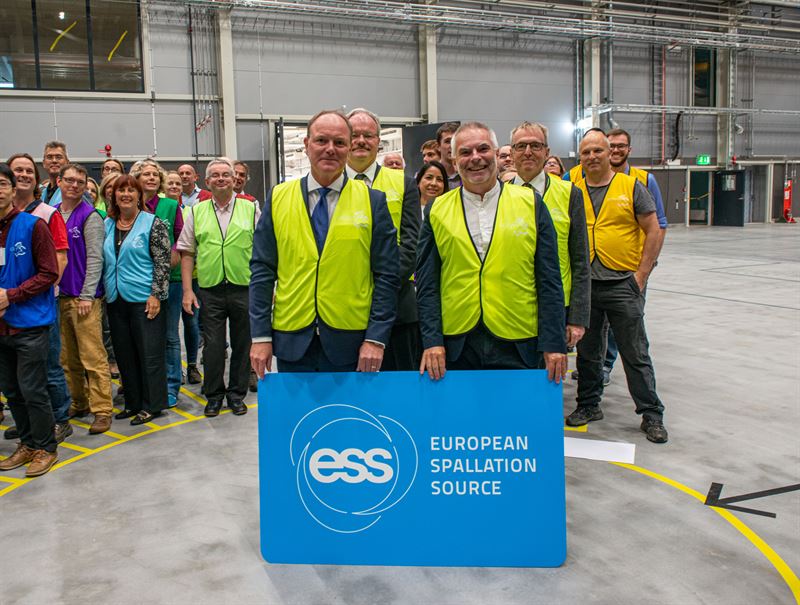ESS initiates installations in the Long Instrument Hall

Yesterday, European Spallation Source (ESS) in Lund, Sweden, celebrated an important scientific milestone, the official handover of the Long Instrument Hall from construction partner Skanska. Kurt Clausen, Vice-Chair of the ESS Council, John Womersley, ESS Director General, Andreas Schreyer, ESS Director for Science, and Per Smidfelt, Skanska Project Director, participated in the ceremony, together with scientists and engineers from ESS and its in-kind partners all over Europe. The celebration marks the beginning of the installation works in preparation for the future scientific instruments at ESS.
The multi-disciplinary research facility ESS, currently under construction in Lund and based on the world’s most powerful neutron source, will deliver world-class science from 2023, enabling scientific breakthroughs in a wide range of areas, such as environment, health, materials and energy. Yesterday, over 200 scientists and engineers involved in the design and construction of ESS’ world-leading instruments celebrated the Handover ceremony of the Experimental Hall, which is an important step towards instrument installations. Many of the attending guests are in Lund this week to participate in the three-day conference IKON17 (17thIn-kind Contributions Meeting for Neutron Science for Instruments), that gathers representatives from ESS and its many in-kind partners to discuss instrument construction and progress. Most of the ESS instruments will be delivered as in-kind contributions, developed and built at research institutes throughout Europe as part of the member countries’ funding of ESS.
”The handover of the Long Instrument Hall is an important milestone on the path to deliver first science at ESS in 2023,” said John Womersley, ESS Director General. “We have moved from construction of the building to the first installations of scientific equipment, working closely with our partners in the member countries who are constructing most of this instrumentation. Together we are strongly determined to make ESS a landmark of European science.”
The fifteen scientific instruments included in the ESS construction project, each unique and optimised to obtain specific kinds of data, are distributed over three Experimental Halls in the research facility. The Experimental Hall now handed over from Skanska will house eight long instruments, which are more than160 metres in length. These instruments need to be placed at a longer distance from the Target station, that is, the world’s brightest neutron source, in order to achieve the high level of detail in the research results, e.g. an atomic resolution of a protein structure. The instruments are specialised in different kinds of experiments in order to support a range of research areas, such as biological molecules, fuel cells, battery research or new computing materials.
“Together with our in-kind partners throughout Europe we are committed to deliver 15 neutron instruments that will enable outstanding scientific results,” said Andreas Schreyer, ESS Director for Science. “We have been working on the ESS instrument suite for many years, and several years of hard work lie ahead of us before completion, but this is a huge leap forward.”
During the ceremony, Per Smidfelt, Skanska Project Director for ESS, handed over a key card to the building to mark the official handover to ESS. The installation works have already started in preparation for the instruments that will eventually be installed in the magnificent bow-formed Experimental Hall, which is approximately 140 metres wide and 13 metres high. The eight long instruments will completely fill the building and at the Handover Ceremony the participants were able to get an idea of their location and size as the shapes of the instrument caveswere marked in the floor.
“For me personally this is a very special moment, as before joining ESS I participated in the development of the engineering instrument BEER, that will be located in this very hall, ” said Andreas Schreyer, ESS Director for Science. “Standing here today I envisage the Experimental Halls at ESS filled with state-of-the-art instruments and top scientists, delivering world-class research.”
The extensive installation works will proceed from now on in preparation for the instruments. A large overhead crane was installed 10 metres above ground earlier this year for instrument installations as well as operations. By the end of the year ESS will also obtain full access to the two adjacent laboratory buildings, where the researchers will prepare their samples before the experiments in the Long Instrument Hall.
For more information:
Julia Öberg, ESS Press Officer, +46 46 888 33 11 or +46 721 79 23 11 julia.oberg@esss.se
The European Spallation Source (ESS) is a Partnership of European Nations committed to the goal of collectively building and operating the world's leading facility for research using neutrons. ESS will provide unique research opportunities within materials research for scientists from all over the world, benefitting the development of better batteries, new medicines and more sustainable materials.
Tags:



